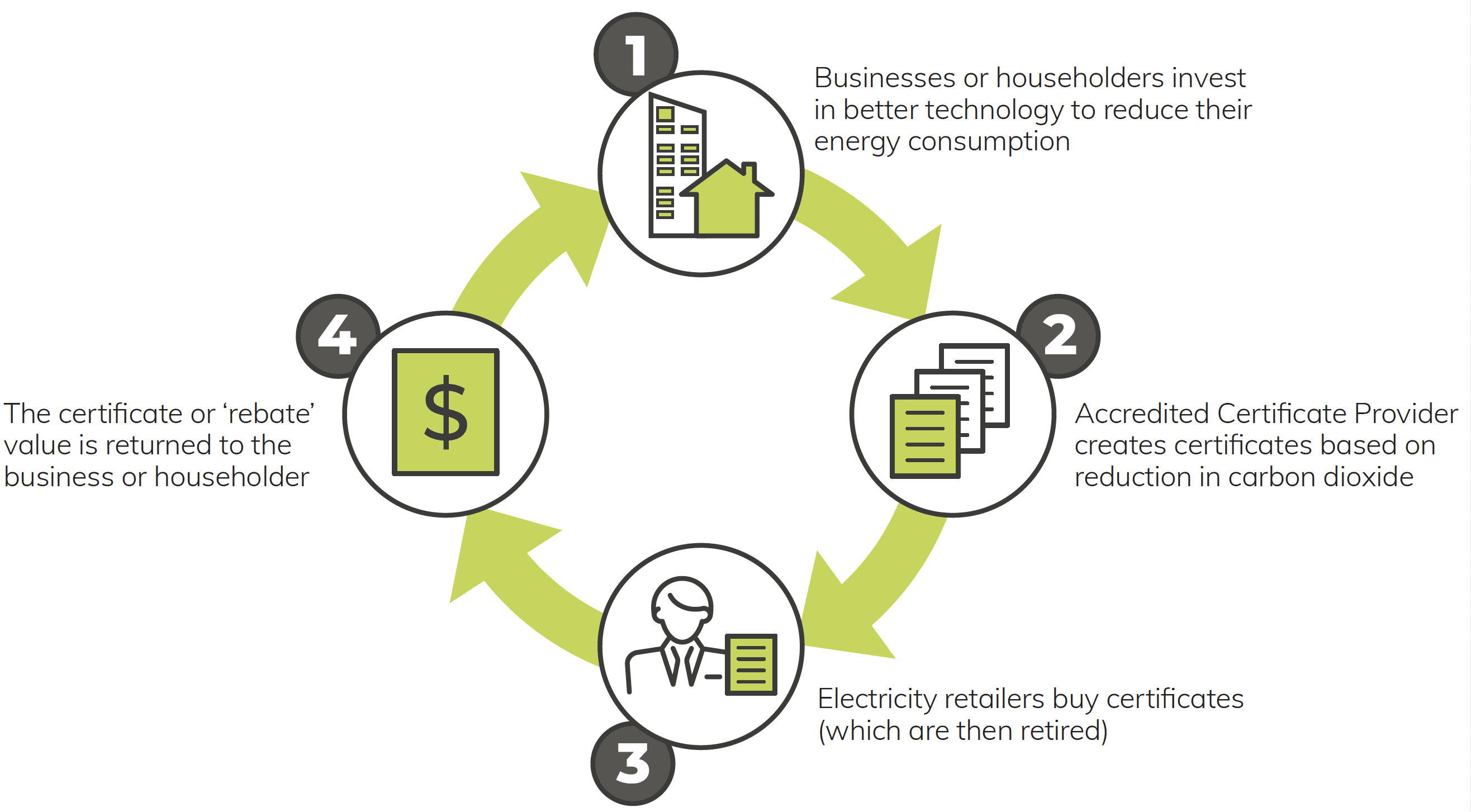Victorian Energy Efficiency Certificates, known as VEECs, can initially appear to be rather complex. At Ecovantage, we are here to help you understand the energy saving programs, and in this blog we’ll help to simplify the process to make your solar array VEEC eligible.
Note: this blog is detailed and technical, focuses on questions we hear from clients, and is relevant for commercial and industrial sized jobs. If you aren’t already familiar with VEECs, we recommend reading our introduction to Solar VEECs post here. And if you encounter any acronyms that aren’t familiar just refer to our Glossary.
What Is a VEEC?
A VEEC is a Victorian Energy Efficiency Certificate, which is created under the Victorian Energy Efficiency Target (VEET) Scheme.
How Is A VEEC Generated?
VEECs are based on the amount of solar energy produced by the solar array, minus your site’s energy usage. The more energy saved by a business, the more Solar VEECs you are able to create.
Each VEEC is representative of a volume of energy saved measured in megawatt hours.
One megawatt hour (1MW/h) of reduced grid energy consumption is equivalent to 0.53 VEEC. Or, alternatively, 1.89MW/h of energy created equals 1 VEEC.
To determine how many VEECs can be created from an upgrade, we calculate the amount of energy reduced at a facility over a year in MW/h by the performed upgraded array and multiply it by 0.53. This gives us the volume of VEECs generated for one year. We then claim this volume of VEECs for the calculated asset lifetime of the technology. For example the calculated asset lifetime for solar is 9.91 years, therefore creating 9.91 years of certificates upfront.
This process is different to the creation of LGCs which requires the solar generation to be monitored monthly and LGCs created on an ongoing basis, with the financial incentives spread out over the coming years.
When Is The VEEC Rebate Paid?
The major point of difference when it comes to VEECs is that they are a “hybrid certificate” in that they are measured for a year (like LGCs) but are then forward paid or “deemed” for the next 9.91 years – much the same as a VEEC is for a lighting upgrade. In terms of offsetting a project outlay, having 9 years of certificates paid at once is extremely attractive. Couple that with a higher certificate price and you start to see why VEECs for solar are so appealing.
Can I Claim VEECs For Any Size System?
Due to the input required to claim VEECs, the scheme only becomes financially viable for larger-scale upgrades that are over 100kW.
Can I Submit The VEEC Claim Myself?
Certificates can only be created by entities accredited by the Essential Services Commission (ESC) under the Victorian Energy Upgrade (VEU) system, such as Ecovantage. These entities are known as Accredited Certificate Providers (ACPs).

Is The Market Volatile?
VEECs are some of the most financially lucrative certificates on the market, with returns that easily outweigh alternative schemes available. However, there is no doubt that the market can be volatile.
At Ecovantage, we understand this, which is why we have options available that mitigate this risk for you. In all VEEC contracts, we are able to offer to lock in a fixed price per VEEC as well as support facilities apply for funding to provide an upfront (pre-measurement and verification) option, which means we are able to guarantee you locked-in rates when the market is strong. This allows you the peace of mind that your rebate pricing won’t be affected by changing prices.
Can An Existing Solar Array Claim VEECs?
VEECs are only available to new solar projects which have not yet begun any construction or works. The scheme is not available to existing solar systems. It is vital to note that projects will be denied by the regulator if any site works have started prior to their approval of an application. This is why it is critical to engage an ACP, like Ecovantage, to obtain approval from the Regulator before works begin.
What Is The 12 Month Measurement And Verification For?
To accurately calculate both the solar production and consumption, we have to establish a consumption baseline by gaining 12 months of data from your business’ energy usage.
Following energisation, there is a 12 month measurement and verification period that ensues. Because a VEEC is representative of energy consumed that has been saved from the grid, each VEEC created is linked to a unit of site activity.
Let’s take a toothbrush factory as an example, we would link every 1 tonne of toothbrushes produced to a unit of energy. Alternatively, if it was a shopping centre, each person who walks through the door is linked to a unit of energy. This process is undertaken by one of our skilled engineers who makes an equation to guarantee you the best outcome in your VEEC claim.
What Happens If The Company’s Production Changes In The M&V Period?
In this period we need to ensure that there are no scheduled or foreseeable disruptions to production or usage. With unpredictable events such as COVID, it begs the question, what happens if due to unforeseeable circumstances, a factory or company needs to shut down or drastically reduce its usage for a period within the measurement and verification timeframe?
Fortunately, the Regulator has released a policy for this. Whether energy production is halted, slowed, adjusted or establishes a ‘new normal’ baseline, there are policies that cover this. As long as the disruption can be directly linked to a state of emergency or state of disaster, it can be handled.
As your ACP, we take care of this for you, so it’s not something you have to be concerned about navigating on your own. Our experienced engineers and compliance teams at Ecovantage will support your claim through every step to approval.
They are experts in the ever-changing VEEC landscape, here to assist you to gain the best possible outcome through the VEU Scheme.
Who Can Claim VEECs?
With the clear financial benefits, there are a few eligibility caveats.
First, the program is only available to Victorian sites. The site needs to have 12 months of energy usage data available prior to system installation to form a ‘baseline consumption’. As long as your site or business has been in operation for at least 12 months prior to installation of the solar array, this data can be obtained.
The site cannot be a registered Scheduled Activity Premises (SAP). The VEU program reduces greenhouse gases by providing access to discounted energy efficient products and services. Scheduled activity premises are exempt from the program, unless the occupier opts into the program. Once the occupier opts into the program, they will be eligible to generate VEECs.
VEECs only become viable for larger-scale upgrades that are over 100kW. And they can only be created by entities accredited by the Clean Energy Regulator (CER) under the VEU system.
At Ecovantage, we have several highly-experienced engineers and compliance officers who take care of the project from start to finish for you ensuring all of the boxes are ticked. They check that everything is generated, compiled and submitted to fulfil the regulatory requirements so that before a project begins, it has been approved and marked as eligible by the Regulator.
How To Explore VEECs For Your Planned Solar Array.
Our experienced team at Ecovantage can guide you through your eligibility, what is required and your estimated VEEC rebate.
To receive a VEEC quote for your system, simply register your interest in Certificate Trading in the form below and one of our team will be in touch with you.
If you do not currently have an eligible project but you would like to explore your options, get in touch below to connect with our certificate experts.

Katie Tebbatt | Business Development Manager, Energy & Carbon Services
Katie specialises in Commercial Lighting (NSW, VIC & SA), Measurement & Verification, and energy certificates including LGCs & ACCUs.
[Updated: 07 Aug, 2024]
 Victoria
Victoria New South Wales
New South Wales South Australia
South Australia Queensland
Queensland

